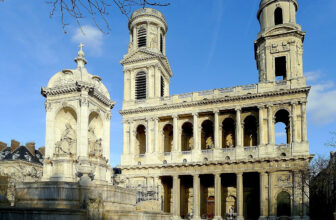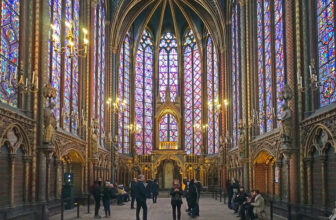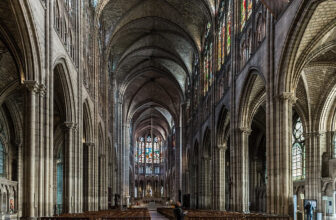
What is so Special about Chartres Cathedral Paris?
Chartres Cathedral, also known as the Cathedral of Our Lady of Chartres (Cathédrale Notre-Dame de Chartres), is widely regarded as one of the greatest masterpieces of Gothic architecture in the world. Situated about 80 kilometers southwest of Paris, in the town of Chartres, France, this iconic structure has captivated the imagination of millions since its construction. Its historical, architectural, and spiritual significance make it a treasure trove of art, culture, and history. But what exactly sets Chartres Cathedral apart from other Gothic cathedrals? Let’s explore its uniqueness through its history, design, craftsmanship, and symbolism.
A Rich Historical Tapestry
The origins of Chartres Cathedral stretch back to ancient times. The site where the cathedral stands was once a place of pagan worship before becoming a Christian site. The first Christian church was built here in the 4th century. Over the centuries, several structures were erected and destroyed on the same site due to fires and invasions.
The current cathedral was largely built between 1194 and 1250, following a devastating fire that destroyed much of the earlier Romanesque structure. Remarkably, the crypt and parts of the western façade survived the fire and were integrated into the new design. This rapid rebuilding effort, fueled by the devotion and financial contributions of pilgrims and townspeople, resulted in a remarkably unified architectural style. Chartres became a center of pilgrimage, primarily because it housed the Sancta Camisia, a relic believed to be the tunic worn by the Virgin Mary during Christ’s birth. This relic further heightened the cathedral’s significance in the Christian world.
Architectural Grandeur
Chartres Cathedral stands as a quintessential example of Gothic architecture, boasting innovations that pushed the boundaries of medieval engineering. One of its defining features is its remarkable height. The interior vaults soar to a height of 37 meters, creating an awe-inspiring sense of verticality that draws the eye upward, symbolizing the human aspiration toward the divine.
The cathedral’s harmonious proportions are a testament to the skill of its builders. Despite its massive size, the structure exudes a sense of balance and grace. This harmony is further accentuated by the use of flying buttresses, a revolutionary architectural innovation that allowed builders to construct higher walls and larger windows. These external supports transferred the weight of the vaulted ceilings away from the walls, enabling the inclusion of the cathedral’s iconic stained glass windows.
The Stained Glass Windows: A Kaleidoscope of Light and Storytelling
One of the most celebrated aspects of Chartres Cathedral is its extraordinary collection of stained glass windows. These windows, which date back to the 12th and 13th centuries, cover an area of approximately 2,600 square meters and are considered one of the most complete and well-preserved collections of medieval stained glass in the world.
The windows serve both aesthetic and didactic purposes. They flood the interior with an ethereal light that transforms the space into a realm of divine beauty, while also conveying biblical stories and moral lessons to an audience that was largely illiterate. Each window is a masterpiece of craftsmanship, featuring vibrant colors and intricate designs that depict scenes from the Old and New Testaments, the lives of saints, and symbolic representations of theological concepts.
Among the most famous windows is the Blue Virgin Window, also known as Notre-Dame de la Belle Verriere. This window, featuring the Virgin Mary enthroned with the Christ Child, is renowned for its striking blue hues, often referred to as “Chartres blue.” The color’s brilliance and depth have captivated visitors for centuries and remain unmatched in their intensity.
The Sculptural Program: A Bible in Stone
The exterior of Chartres Cathedral is adorned with an extensive array of sculptures that serve as a “Bible in stone.” These sculptures, located on the three main portals, the Royal Portal, the South Portal, and the North Portal, depict a wide range of biblical stories, figures, and themes.
The Royal Portal, located on the western façade, is particularly notable for its depiction of Christ in Majesty surrounded by the symbols of the four evangelists. The figures are elongated and stylized, embodying the spiritual ideals of the Gothic era. The sculptures also include scenes from the life of Christ, the Virgin Mary, and the Last Judgment, offering a visual catechism for medieval worshippers.
The portals of the north and south transepts further enrich the cathedral’s narrative program. The North Portal is dedicated to the Old Testament and the Virgin Mary, while the South Portal focuses on the New Testament and the Last Judgment. Together, these sculptures create a cohesive theological vision that guides viewers through the core beliefs of Christianity.
Spiritual Significance
Chartres Cathedral has been a major pilgrimage site for centuries, attracting countless visitors seeking spiritual solace and divine intervention. The Sancta Camisia, the sacred relic housed in the cathedral, has been a focal point of veneration. Pilgrims believe that the relic has miraculous powers, and its presence has made Chartres a destination for those seeking healing and blessings.
The labyrinth embedded in the cathedral’s floor is another element of spiritual significance. Measuring 12.9 meters in diameter, the labyrinth is a meditative tool that symbolizes the journey of the soul toward God. Pilgrims would walk its intricate path as a form of prayer and contemplation, reflecting the spiritual pilgrimage of life itself.
Preservation Through the Ages
Despite the passage of centuries, Chartres Cathedral has remained remarkably intact, surviving wars, revolutions, and natural disasters. During World War II, the cathedral narrowly escaped destruction when Allied forces debated bombing it to prevent its use as a German observation post. Fortunately, a reconnaissance mission confirmed that the Germans were not occupying the cathedral, sparing this irreplaceable treasure.
In recognition of its historical and cultural significance, Chartres Cathedral was designated a UNESCO World Heritage Site in 1979. Extensive restoration efforts have ensured the preservation of its architectural and artistic elements, allowing future generations to marvel at its splendor.
A Symbol of Human Achievement
Chartres Cathedral is an evidence to the ingenuity, faith, and creativity of the medieval world. The dedication and craftsmanship that went into its construction reflect a profound commitment to creating a space that embodies the divine. Its architectural innovations, artistic achievements, and spiritual resonance continue to inspire awe and admiration.
Moreover, the cathedral serves as a reminder of the enduring power of art and architecture to transcend time and connect people across generations. Whether one approaches it as a pilgrim, an art lover, or a historian, Chartres Cathedral offers an experience that is both deeply personal and universally resonant.
Chartres Cathedral is special because it encapsulates the essence of Gothic art and architecture while serving as a beacon of spiritual devotion and human creativity. Its towering spires, luminous stained glass, intricate sculptures, and profound symbolism make it a masterpiece that continues to inspire awe. Visiting Chartres Cathedral is not merely an encounter with history; it is an invitation to step into a space where the sacred and the sublime converge, offering a glimpse of the eternal.
In a world where so much has changed, Chartres Cathedral stands as a timeless reminder of humanity’s enduring quest for meaning, beauty, and transcendence.




